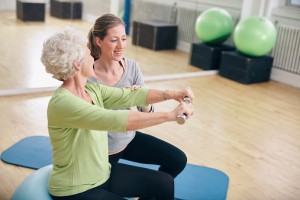

 Exercise can seem near impossible if you have arthritis pain. Arthritis is a condition which affects the joints, and there are over 100 different types of arthritis. No one is immune to developing arthritis; it affects an estimated 50 million American adults.
Exercise can seem near impossible if you have arthritis pain. Arthritis is a condition which affects the joints, and there are over 100 different types of arthritis. No one is immune to developing arthritis; it affects an estimated 50 million American adults.
Arthritis can leave your joints feeling stiff, swollen, sore, and it can even limit your range of motion. Arthritis is a joint disease and exercise requires the use of your joints, so it may seem near impossible to partake in exercise; however, new research suggests it may be the best thing you can do.
 Norway researchers examined the effects of exercise on arthritis by asking 18 females to partake in a 30-minute high-intensity, interval spinning class twice a week for 10 weeks. The women were to track their fitness along with inflammation markers and levels of pain.
Norway researchers examined the effects of exercise on arthritis by asking 18 females to partake in a 30-minute high-intensity, interval spinning class twice a week for 10 weeks. The women were to track their fitness along with inflammation markers and levels of pain.
The usual effects of exercise occurred in the women, including weight loss, improved stamina and reduced fat. But in regards to arthritis inflammation, markers decreased as well, including stiffness, pain and swelling.
Although the study was small, it was the first to reveal the benefits of exercise for those with arthritis and to show that vigorous exercise is safe for people with arthritis. Lead researcher, Anja Bye, said, “All of the women in the study were capable of participating in this type of high-intensity exercise program without any negative side-effects.”
Not only did the women reduce inflammation markers, but there was no increase in biomarkers either – pain, inflammation or joint damage. Exercise, even the vigorous variety, was deemed safe for all participants – even those in the older age range – which furthers the notion that no matter how old we are, or what issues we have, we should try to exercise regularly.
Exercise isn’t only for those with arthritis; we should all be exercising as a good practice for overall health and well-being. Here is a list of other benefits we can obtain from regular exercise.
 If you have been out of the game, so to speak, for a prolonged period of time, it may be daunting to try and embark on an exercise regimen. Don’t fret – exercise can be started at anytime and at any level.
If you have been out of the game, so to speak, for a prolonged period of time, it may be daunting to try and embark on an exercise regimen. Don’t fret – exercise can be started at anytime and at any level.
First and foremost: know your capabilities and work with that. Don’t try to over-exert yourself as it will only result in injury. You may wish to start with range-of-motion exercises and stretches. This type of exercise entails moving the joint as far as it can go (without pain). Stretching will allow you to improve your range-of-motion, or you can try yoga and tai chi.
Once you’ve mastered range-of-motion you can move up to endurance or conditioning exercises. These exercises may involve a brisk walk, swimming, aerobics or even going up and down stairs.
Lastly, another type of essential exercise is strengthening exercise, which will maintain muscle strength. This is done through resistance training – or the use of weights. Don’t worry about starting off with heavy weights; even lifting water bottles at first can offer resistance until you build yourself up.
If you have clearance from your doctor to get moving, we highly recommend you get started. If you need help in the beginning, you may want to seek out a physical therapist for guidance.
Should you exercise is you have arthritis?
If we have an underlying health condition, like arthritis, exercise may be difficult and almost scary. No matter the benefits, if we think exercising will increase our pain, it’s likely we’ll avoid it. Here’s what you need to know about staying active with arthritis. Continue reading…
Facts about osteoarthritis
Osteoporosis is a condition that affects the bones. Bones become brittle and more likely to fracture. Osteoarthritis, on the other hand, is a painful form of arthritis that affects the joints in the body. Continue reading…
Copyright © www.orthopaedics.win Bone Health All Rights Reserved